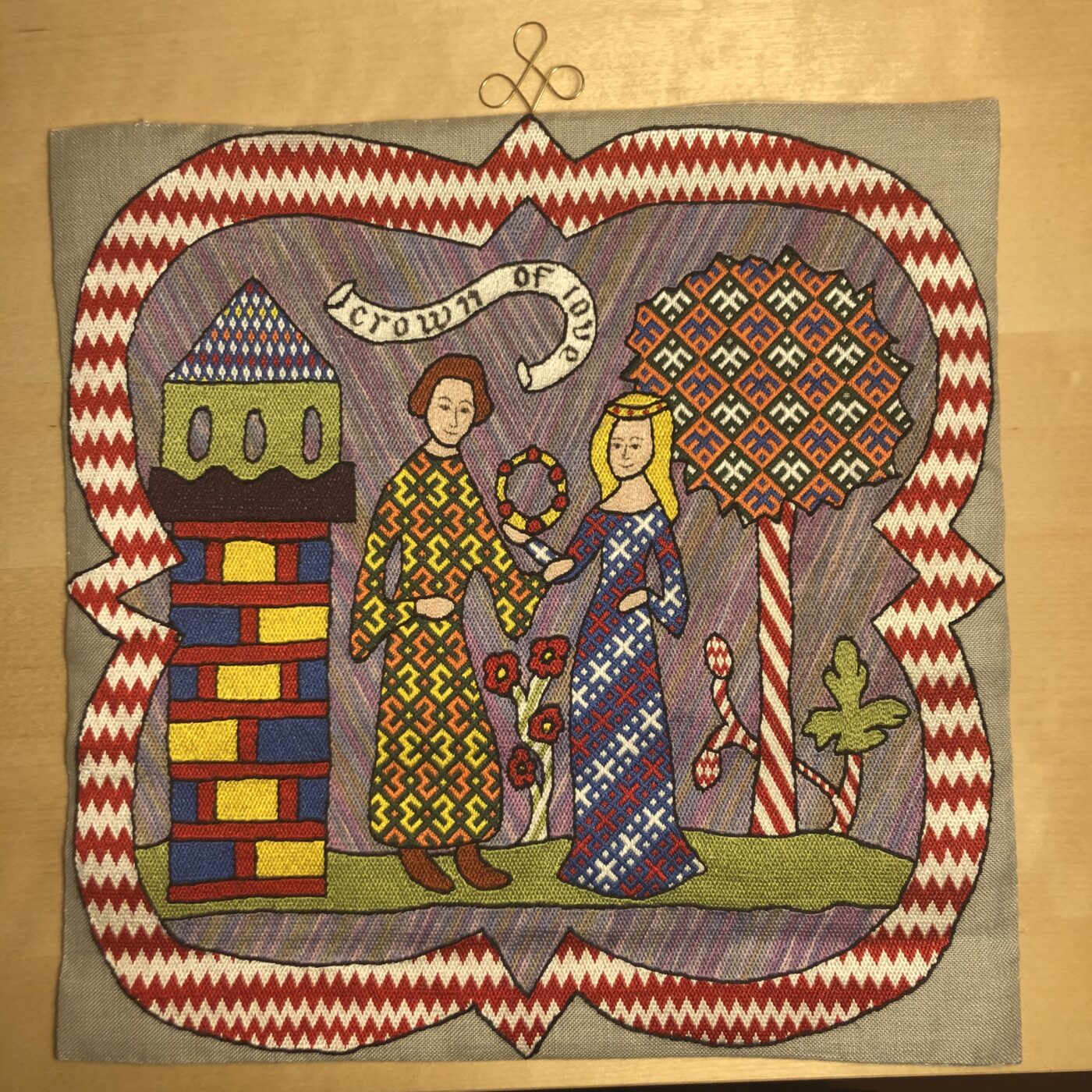Wiki: https://wiki.eastkingdom.org/wiki/Scolastica_Capellaria
Blog: https://theinevitablescadian.home.blog/
This embroidered wall hanging is a secular interpretation of one of the scenes in the “14th Century wall hanging” in the metropolitan Museum of Art. This piece was cut in half to sell to the Met at some point in its life. Its other half was lost in WWII, however a black and white photograph survives to present day showing the different scenes and German brick stitch patterns used in this piece. The extant embroidery was made in Lower Saxony, possibly in Hildesheim. Historians argue whether it was made by a group of nuns, lay women or professional embroiderers. However, I believe the scope and breadth of this work points to a professional group who might not have been part of a guild but devoted much of their life to embroidery or other textile arts.
Brick Stitch is a style of embroidery popular in Germany in the 1300s and is notable for its bright use of complementary colors and geometric patterns. The wall hanging at the Met is silk on linen and made almost entirely using brick stitch. The stitches of brick stitch are stitched vertically up and down on the canvas, thus avoiding distortion. Each of the beautifully complex patterns is counted and stitched onto the linen canvas by counting the fabric of the ground cloth (in a similar way to modern cross stitch). The figures are also outlined using outline stitch, and Kloster stitch is used for the faces. Details on the faces and scripts are painted on top of the embroidery in ink.
Materials
This piece was stitched using spun silk floss on even weave line fabric. An archival marker was used to mark the design on the fabric before stitching. Archival grade watercolors (pigment suspended in gum Arabic) were used to paint the faces and script on the scroll.
I chose a variegated spun silk floss thread for the background field. If you look carefully at the original piece, you can see that the background is variegated. However, it also appears so are all the other colors. Whether the piece started with variegated thread, or it changed over time due to the fading of pigments is an open question. Additionally, it is possible that the makers did not intend to use variegated thread, but due to the dying process, the thread had variations. Should I complete another piece like this one I would choose a background thread that was less variegated than the one I ultimately chose for this project. Additionally, I would likely choose silks for the entire project that had some variation in them rather than combining solid and variegated threads.
In this period, it is likely that the silk used was filament silk rather than spun from a real. I chose spun silk due to its relative affordability and availability of colors.
I chose a greyish even weave linen fabric for this project. Because I do not have access to photos of the reverse of the wall hanging, I do not know the exact kind of fabric use, but through measurements available online and an educated guess I believe this fabric is similar thread count to what was used in the original.
Technique
My piece was stretched on a scroll frame. The original was likely stretched on a slate frame and worked by many hands at the same time.
Design
I chose designs and colors I felt were most accurate to the theme of the original piece. The design of this piece is a single quatrefoil framed scene of the style in the Met Wall Hanging. I focused on a theme popular in the 1300s, crowning one’s lover with a crown of love. This theme can be seen on ivory mirror cases and carvings and appears often in literature.
I chose different elements from several of the framed scenes of the Met piece including a castle, king David receiving a flower crown, and a very strange Dr. Seussian tree. Each of the elements of the piece including the patterns were pulled directly from the 14 th Century Wall Hanging.
A full explanation of the patterns chosen, samples, color swatches and academic sources can be viewed in my long form documentation.
Full Documentation
Blog with additional photographs and information

Wow, this is gorgeous! I love the intricacies of the different patterns and colors and how they complement each other. And I enjoyed learning more about brick stitch and the historical pieces you included in your documentation. Thank you for sharing!
This is beautiful! It is so inspiring that now I want to try something like this myself! And there is so much information about the process, the materials, and the stitching in the documentation, I feel I can use that to make a great start of it. Thank you so much!
Fabulous work! I love the description of the tree as “Dr Seussian”
The composition and color choices are wonderful!
I love German Brick Stitch. It’s simple, but always so colorful. And yes, totally “Dr. Suess” like in appearance! Thank you for sharing your beautiful embroidery.
-Magistrissa Anna Dokeianina Syrakousina, OL. Trimaris.
This piece is charming! It’s very interesting to read about your color and pattern choices, and your experiments with stitch direction. I enjoyed reading your speculation on how embroiderers in period would have felt about doing work like this, which you found a bit dull once you had mastered the techniques. Thank you for sharing!
So gorgeous! I really like the way you synthesized the different figures to create your own image. It’s very much your own design, but still firmly within the historical examples.